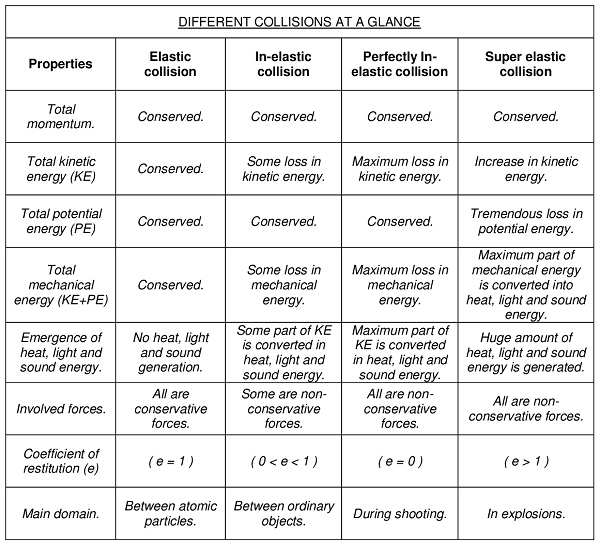What is called a Collision?
Collision is an event in which two moving bodies or one moving body and other stationary body collide (strike) with each other.
Collision between two bodies is said to be occur –
- If the bodies physically collide with each other.
- If the path of one body is affected by the force exerted by the other body, without a physical contact of collide or striking between them.
Therefore, for a collision of bodies to take place, actual physical contact between the bodies is not a necessary condition.
Example –
- In Rutherford’s scattering experiment ( \alpha ) particles get scattered due to the electrostatic force between ( \alpha ) particles and nucleus without any physical contact. The ( \alpha ) particle is said to have collision with the nucleus without physical contact.
- Two balls ( A ) and ( B ) are thrown on floor one after the other to move on same straight line path. If the velocity of ball ( B ) thrown latter is more than velocity of ball ( A ) , then after certain time it will hit the ball ( A ) and may change its path and motion both. The balls ( A ) and ( B ) are said to be in collision with physical contact.
Types of Collision
Based upon the effects on bodies after collision, these are classified as follows –
- Elastic collision.
- Inelastic collision.
- Perfectly inelastic collision.
- Super elastic collision.
- Head – on collision.
- Oblique collision.
Each type of collision is explained separately as follows –
Elastic Collision
In an elastic collision, no loss in kinetic energy takes place.
Characteristics of elastic collisions are –
- Total momentum is conserved, i.e. total momentum before collision is equal to total momentum after collision.
- Total energy is conserved, i.e. total energy before collision is equal to total energy after collision.
- Total kinetic energy is conserved i.e. total kinetic energy before collision is equal to total kinetic energy after collision.
- All forces acting on the system are conservative forces.
Example –
- Collisions between subatomic particles.
- Collision between glass balls.
In-elastic Collision
In an in-elastic collision, a loss in kinetic energy takes place.
Characteristics of elastic collisions are –
- Total momentum is conserved i.e. total momentum before collision is equal to total momentum after collision.
- Total energy is conserved i.e. total energy before collision is equal to total energy after collision.
- Total kinetic energy is not conserved i.e. total kinetic energy before collision is not equal to total kinetic energy after collision.
- A part of kinetic energy is converted into heat, light or sound energy.
- Some or all of the involved forces are non conservative forces.
Example –
- Collision between two vehicles on road.
- A Collision between a ball and floor.
Perfectly in-elastic Collision
Colliding bodies stick together and move as a single unit after collision in a perfectly in-elastic collision.
Characteristics of perfectly in-elastic collisions are –
- Momentum is conserved i.e. total momentum before collision is equal to total momentum after collision.
- Total energy is conserved i.e. total energy before collision is equal to total energy after collision.
- Total kinetic energy is not conserved i.e. total kinetic energy before collision is not equal to total kinetic energy after collision.
- Maximum part of kinetic energy is converted into heat, light or sound energy.
- Some or all of the involved forces are non conservative forces.
EXAMPLE –
- Mud thrown on a wall and sticking to it.
- A bullet fired into a wooden block penetrated and remain embedded in it.
Super-elastic Collision
In super-elastic collision, there is an increase in kinetic energy. It is also called an explosive collision.
Characteristics of super-elastic collisions are –
- Total momentum is conserved i.e. total momentum before collision is equal to total momentum after collision.
- Total energy is conserved i.e. total energy before collision is equal to total energy after collision.
- Kinetic energy of the system increases.
- Increase in kinetic energy is the result of conversion and release of potential energy of system into kinetic energy due to impact.
Example –
- Bursting of crackers.
- Hitting of a trolley with another trolley fitted with a compressed spring releasing the potential energy stored in the spring.
Head-on Collision
In head-on collision, the two colliding bodies move along the same straight line path before and after the collision. It is also called as one dimensional collision.
Characteristics of head-on collisions are –
- Total momentum is conserved i.e. total momentum before collision is equal to total momentum after collision.
- Total energy is conserved i.e. total energy before collision is equal to total energy after collision.
Example –
A collision between two moving cars facing to each other.
Oblique Collision
In oblique collision, the two colliding bodies move on same plane but not move along the same straight line path before and after the collision. It is also called as two dimensional collisions.
Characteristics of oblique collisions are –
- Total momentum is conserved i.e. total momentum before collision is equal to total momentum after collision.
- Total kinetic energy is conserved i.e. total energy before collision is equal to total energy after collision.
Example –
Collision between carom-board coins.
Comparative study of Collisions
A comparative analysis about the properties of bodies before and after collisions are made. The basic differences in different modes of collisions are listed for better understanding of them. These are tabulated below –

